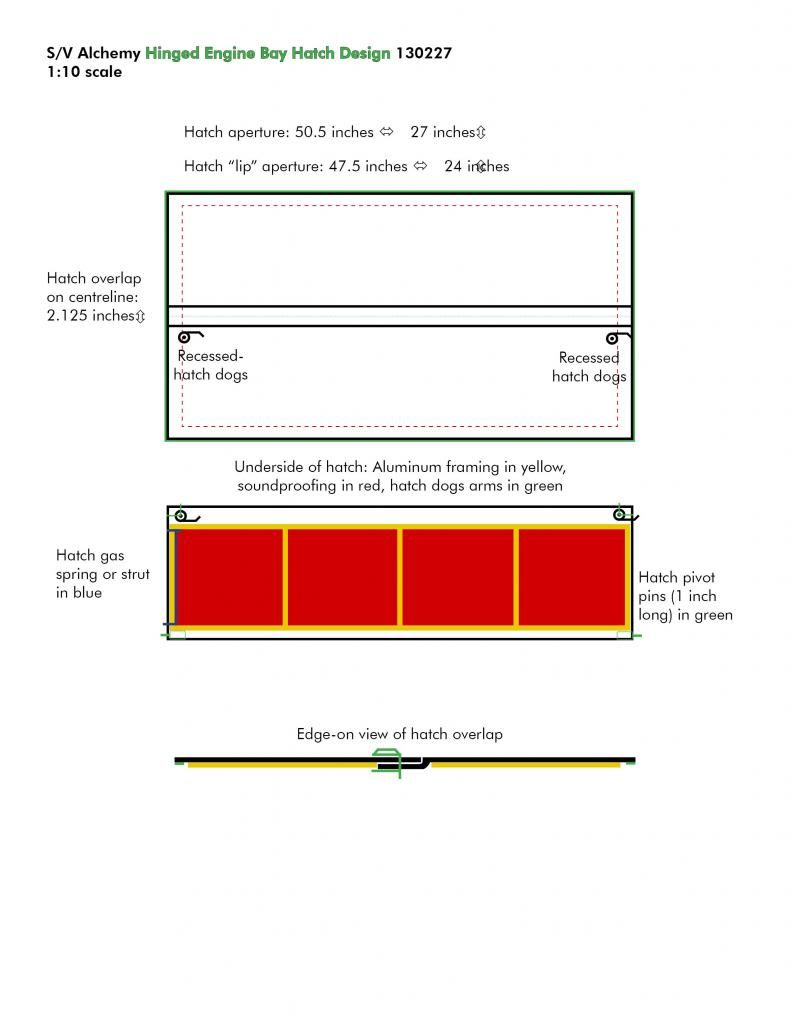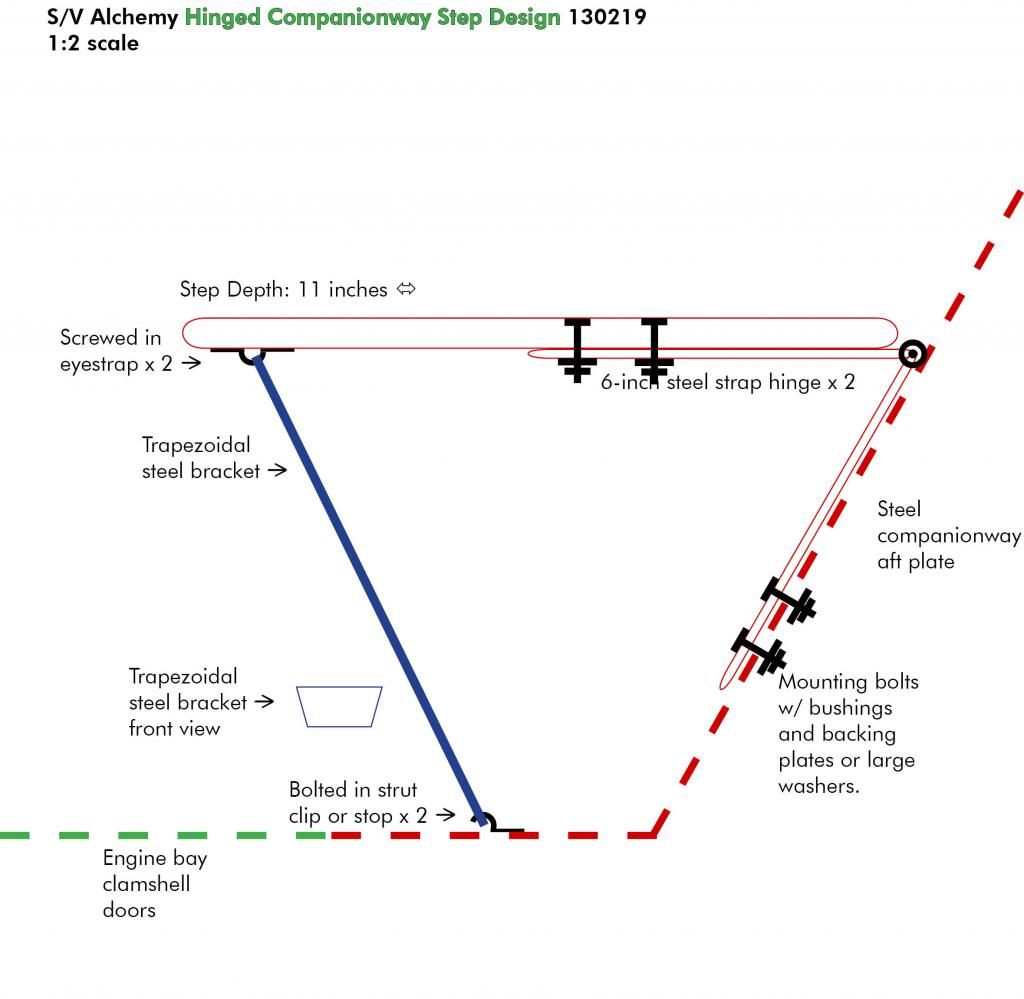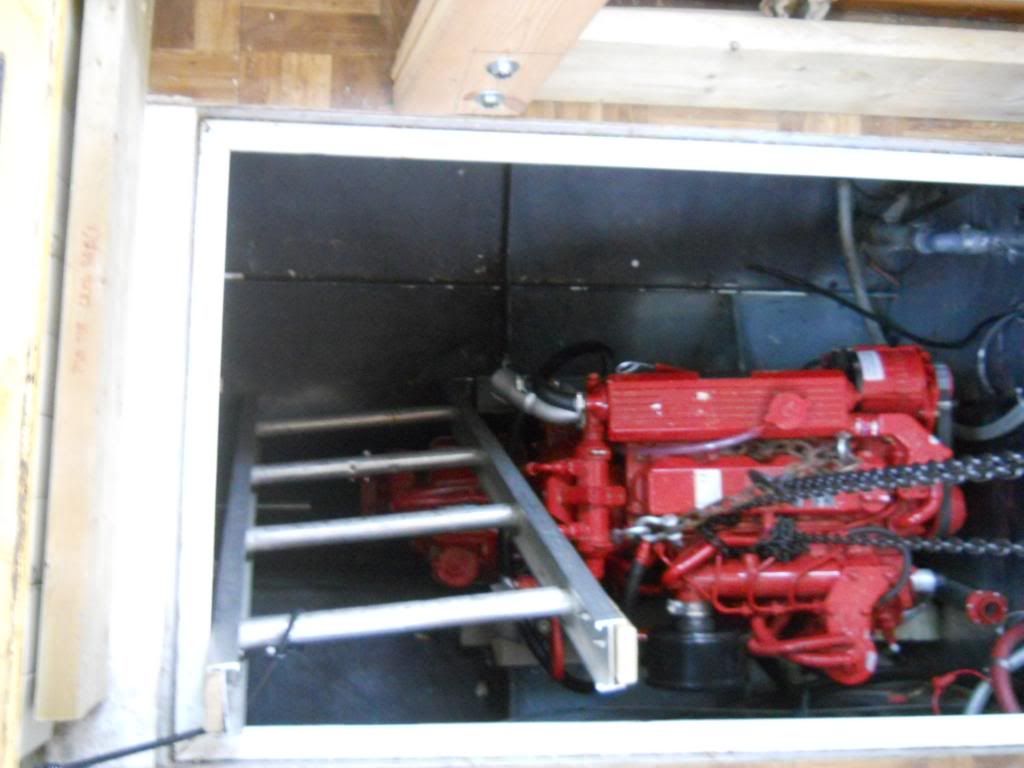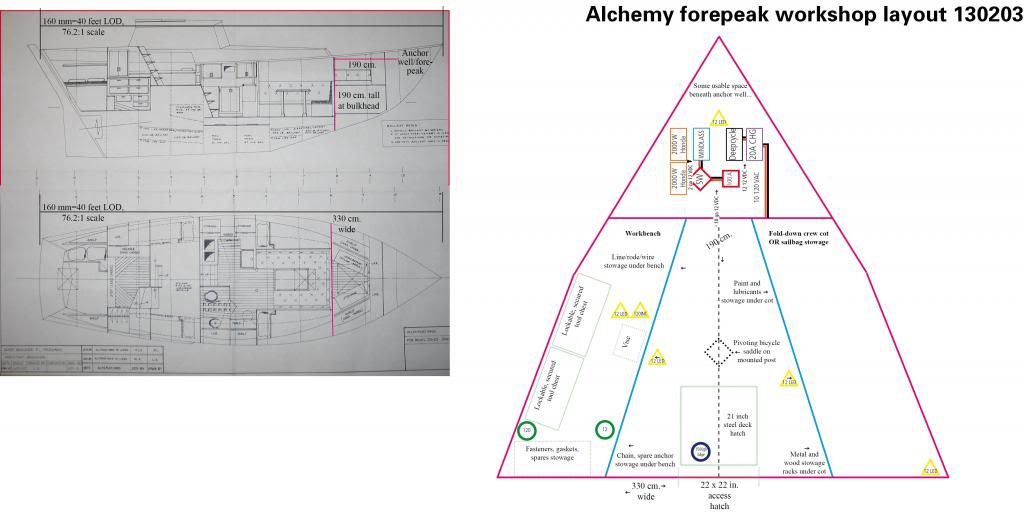 |
| How hard can two rectangles be? I guess we will find out. |
Recently, I've had to research every type of "gas spring", which is the name of the category, by the way, for the lifting mechanism of every sort of hatch or platform that is heavier than something a simple bronze or stainless strut would hold open with confidence, which is why it's top of mind.
 |
| Related project to the engine bay "clamshell" hatches: For them to open, the last step into the pilothouse must raise or lower out of the way. |
 |
| Watch that last, missing step. It's a doozy. |
 |
| Works in the right direction, but is too big and too strong. |
So my design is much simpler. An eye and hook can secure it, or even a loop of bungee, and a metal "C-strut" can support even the impact weight of a wet crew stomping on it.
| Pretty representative of the genre |
As for the bay hatches, this type of gas spring is nice, although I could just as easily use the very same sort of sliding hatch strut used on most deck hatches. The doors have to be kept open, and that means only their own weight has to be supported when open. When closed, the frame of the "bay hole" itself, plus the overlapping center "lip" does that job, unless my design, currently under review by a fabricator, is insufficient.
On the subject of where the backsides go, as the pedestal type of gas spring for helm seats are quite spendy, you could get everything from a bus driver's seat mount to a salvaged barbershop chair base to accomplish the same action in a compact manner.
 |
| Priced with the customary "Marine means times three" factor |
We actually tried to acquire a "salon chair" for $99 last year, but we didn't get a call back. Might have been a dodged bullet, as I suspect the pedestal to seat plates and pedestal to floor connections are both robust and less prone to corrosion than barbershop specs typically are.
The reasons for this particular line of enquiry is because there is a height discrepancy between my wife (and my son for the near term) and myself. We therefore require a helm seat in the pilothouse that can move up and down and fore and aft. Ideally, a sailing helm seat would pivot side to side on some sort of friction fitting, either to make sailing on a heel comfortable (if one was, for instance, on a night watch during a cold rain from the pilothouse in the mid-Atlantic) or to shift side to side in a cross-swell. According to a recent thread I started in Cruisers' Forum, however, that particular sort of pedestal seat base doesn't seem to exist currently. So it may end up being another fabrication job, or we make do with an off-the-shelf solution.
 |
| Eh, may be overkill...the measuring tape will confirm, but the arm and foot rests are nice |
Strangely, I have done exactly that with the seating solution I envision for the forward workshop. Preliminary designs, taking into account the time likely to be spent in there, the need to shift my weight and the space available, gave me a very quick idea I might not have otherwise had if I drove a car: a bicycle seat on a post. For better or for worse, I am used to bike saddles, and I can literally salvage everything I need out of my garage. I can even make it spin...
 |
| I'm looking forward to this part of the rehab, actually. It's probably within my skill set to do it right. |
Back to the "strutting", I need to investigate gas springs for my engine bay hatch and my steel forepeak deck hatch, both of which will be "unlight". Another dinette-weight project will be the new saloon companionway steps I am planning to frame up, which will cover eight Trojan L16s in a welded, stepped box, which will themselves contain battery boxes for each pair. One of the very few things I like about current showroom queens are the gas springs that allow a companionway hinged at the top to rise with a kid's grade of arm strength and stay put under pulled down, much like a well-fitted sash window.
 |
| This is bigger than I'll need...it's from a Beneteau 55... but picture something similar going up like a van's rear hatch. |
The point is to take all the half-ton of batteries I intend to carry right to the CE of the entire boat, meaning I can dispose of the lead pigs acting as trim ballast forward...and replace it in part with tools and spares.
The gas springs used for truck engine hoods should be about the right size. You could use gas springs in combination with a locking strut in a number of applications around the boat in a similar fashion, including fold-away or fold-up table or nav station surfaces.
Lastly, today's hot boater tip is that Lee Valley seems to be selling moddable warm white and coloured LED strips for a price I find reasonable, and will do so for bulk discount. Many sailors have for many years been taking out the old auto-type 12VDC incadescent bulbs in favour of LEDs, particularly as the first-generation "cold and bluish" type have declined in favour of "warm white. But this Lee Valley system is more or less snap-together, looks nice (I've seen them in person) and dimmable, all attributes that are like catnip to the amp-conserving average boat fixer. I saw the RGB ones and thought "hey, go from 'blended' white to pure red in the pilothouse with the turn of a pot dial? I can get behind that!"
 |
| Part Lite-Brite, part Lego. |
We are pretty much at the break point between me wiring up strips off a spool obtained from an "industrial concern" and the price of retail at places like Lee Valley. I thought I'd have to make and measure my lighting, but it's going "prêt-à-porter": just buy what you need and screw it down.





2 comments:
A word from experience (you said you don't have a car... I drive old ones), gas shocks depend on a trapped hi-pressure bubble of gas inside. Since no seal is perfect, you can probably guess what happens over time. I have replaced the hood and hatchback gas struts on my 1985 TransAm twice, so far.
Make sure that whatever you design for, it is a common size. Buying spares ahead of need might not work - a few molecules of gas (usually nitrogen) are always sneaking past the seals.
Thanks for the tip on the LED strip lites - I'm getting ready to do a project that will involve them.
bob
s/v Eolian
Seattle
Thanks for that bit of real-life experience. Given that the engine bay hatches shown are going to be pretty light, I could use struts or folding "lie-flat" brackets just as easily...and perhaps now may do that.
The only place where the weight involved (and the one-handed lift) might pose issues would be the lower of the two companionways, the steps down into the saloon. These are to be reconstructed to cover two tiers of tall batteries in their boxes, plus the existing fuel manifolds and the existing stnadpipe with its "Ts" for head, galley and engine cooling.
That's going to be a fairly substantial piece of steps and riser, for lack of a better term, and will have to "fly up" with some sort of assist.
But if it lasts five years, I'm OK with it. I can always rig a purchase if needed.
Thanks for the comment.
Post a Comment